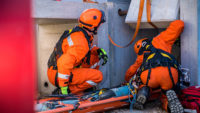We do what we do to obtain, avoid, or escape certain consequences. Consequences we work to obtain are termed "positive reinforcers." Consequences we attempt to avoid are "negative reinforcers."
But the context in which behavior is performed is also a factor. Some work environments make positive consequences for safety-related behavior (positive recognition or supportive feedback) a rarity. Meanwhile, the expectation of a negative consequence for observed at-risk behavior is omnipresent. In this organizational climate, people develop an unpleasant "failure-avoiding" mindset in lieu of a more desirable and self-motivating "success-seeking" outlook.
These perceptions and expectations can lead to a positive or negative attitude toward a task or challenge. They influence our demeanor and motivation to perform. Now we're talking about a person-state.
From external to internal factors
Applied behavioral science, the foundation of behavior-based safety (BBS), improves human behavior by defining and manipulating relevant external or environmental factors -- from situational variables that can activate or direct desirable behavior to consequences that can support or stifle such behavior. This is termed the ABC Model--Activator-Behavior-Consequence.
But sometimes behavior seems to occur without observable influence from external factors. In this case, we assume primary behavioral control by a personal disposition. Some behavioral scientists refer to this as self-talk or “rule-governed behavior;” others label the behavior "discretionary," "self-directed," or "self-motivated."
For example, in an article on process safety for the Journal of Organizational Behavior Management, Drs. Cloyd Hyten and Timothy Ludwig describe the self-directed and safety-related behaviors of the elite pilots of the U.S. Navy "Blue Angels" and the most experienced space-shuttle commander in NASA history. After every air show the elite pilots meet to review each aspect of their air show and give each other performance feedback. Similarly, Astronaut Jim Wetherbee keeps a detailed log of his performance errors in order to discover trends and reduce behavioral variance.
Absent external activators or consequences to direct and motivate such tedious and time-consuming behavior, the pilots and astronaut are self-directed or self-motivated.
What does this mean, and how can we increase the probability of self-motivated behavior for workplace safety?
The competence person-state
Research has shown that self-motivation is determined by an individual's perception of personal choice, relatedness or sense of community, and personal competence. I want to focus on the perception of personal competence--a person-state that inspires self-directed and self-motivated behavior.
Humans need to feel competent at performing worthwhile work, and behavioral feedback can help to fill that need and bolster a person-state of competence. Might this be the motive for the "Blue Angels" and Astronaut Jim Wetherbee systematically reviewing their professional behavior? Could the personal label of "competent safety leader" influence safety-supportive behavior absent an extrinsic accountability system?
Enhancing a competence person-state
Just as the physiological states of food satiation and deprivation influence the occurrence or nonoccurrence of food-related behavior, psychological dispositions or person-states can affect the relevance and influence of particular response-consequence contingencies. When certain environmental conditions or operations enhance a particular person-state, the probability of relevant behavior occurring is increased.
Situational factors that fuel self-motivation increase the occurrence of that behavior. Since many safety-related behaviors need to occur without the influence of extrinsic directives and consequences, self-motivated behavior is frequently required to keep people injury free.
I’ve identified events, situations, and contingencies that enhance or stifle specific person-states that can activate self-motivated behavior. For example, what situational factors can influence a perception and self-label of “safety competence,” and increase the occurrence of self-motivated safety-supportive behavior?
First, it's necessary to believe that safety competence is a worthwhile and highly-regarded label and a desirable person-state. Numerous situational variables, from personal communication to policy decisions, influence the cultural value of “safety competence.”
“Safety competence” is a worthwhile person-state. So what situational or cultural manipulations can support this personal perception and indirectly activate safety-related behavior. At the top of my list: positive recognition and supportive feedback for safety-relevant behaviors enable a person to feel “safety competent.”
Many other situational and cultural factors can enhance this person-state: a special safety assignment or safety leadership role, a social media report that identifies a person's safety contribution, a reward for contributions to workplace safety, a peer-to-peer safety observation and feedback session that is well received, and any interpersonal conversation that mentions an individual's expertise for a safety-related accomplishment or challenge.
To conclude
Behavior is an outcome of both situational and dispositional (or personality) factors. Personality characteristics are relatively stable traits, or they are states that vary as a function of the situation or context. In this article, the person-state of “safety competence” is viewed as a disposition we need to enhance in others. Why? To indirectly influence the occurrence of safety-related behaviors in the absence of external accountabilities--when no one’s watching.
The evidence-based assumption: People who feel safety competent and believe this person-state is valuable and appreciated are likely to be self-motivated to support an injury-free workplace when external directives or consequences are not evident.
Our challenge: Create situations and systems that emulate the label and support the person-state of “safety competence.”



